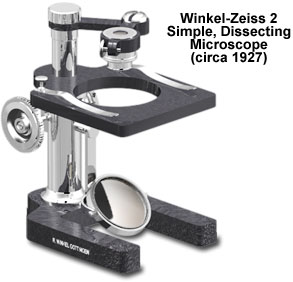Winkel-Zeiss 2 Dissecting Microscope
In 1911, Carl Zeiss and the Rudolf Winkel microscope firm of Göttingen, Germany formed a partnership and separate corporation known as R. Winkel GmbH, which thrived and grew to 360 employees before the post-war crash of 1945. The Winkel-Zeiss 2 dissecting microscope featured below is a product of their joint venture and was designed to meet the needs of beginning biology students in the 1920s.

The simple lens or loupe of the instrument is available in 7x, 10x or 15x magnifications, and a rack and pinion mechanism translates the lens and jointed arm up and down in relation to a large, black stage. The fixed stage features a wide, circular aperture and two specimen clips. Also, a gimbal-mounted mirror is attached to a swing-out arm that enables episcopic or diascopic illumination. The instrument is designated "Winkel Nr. 222" and is inscribed "R. Winkel, Göttingen" on the side of its horseshoe-shaped foot. Around 1935, however, the name of the optics works and microscope factory was changed to Zeiss-Winkel, later becoming the microscope division of the West German branch of Carl Zeiss.
BACK TO TWENTIETH CENTURY MICROSCOPES
